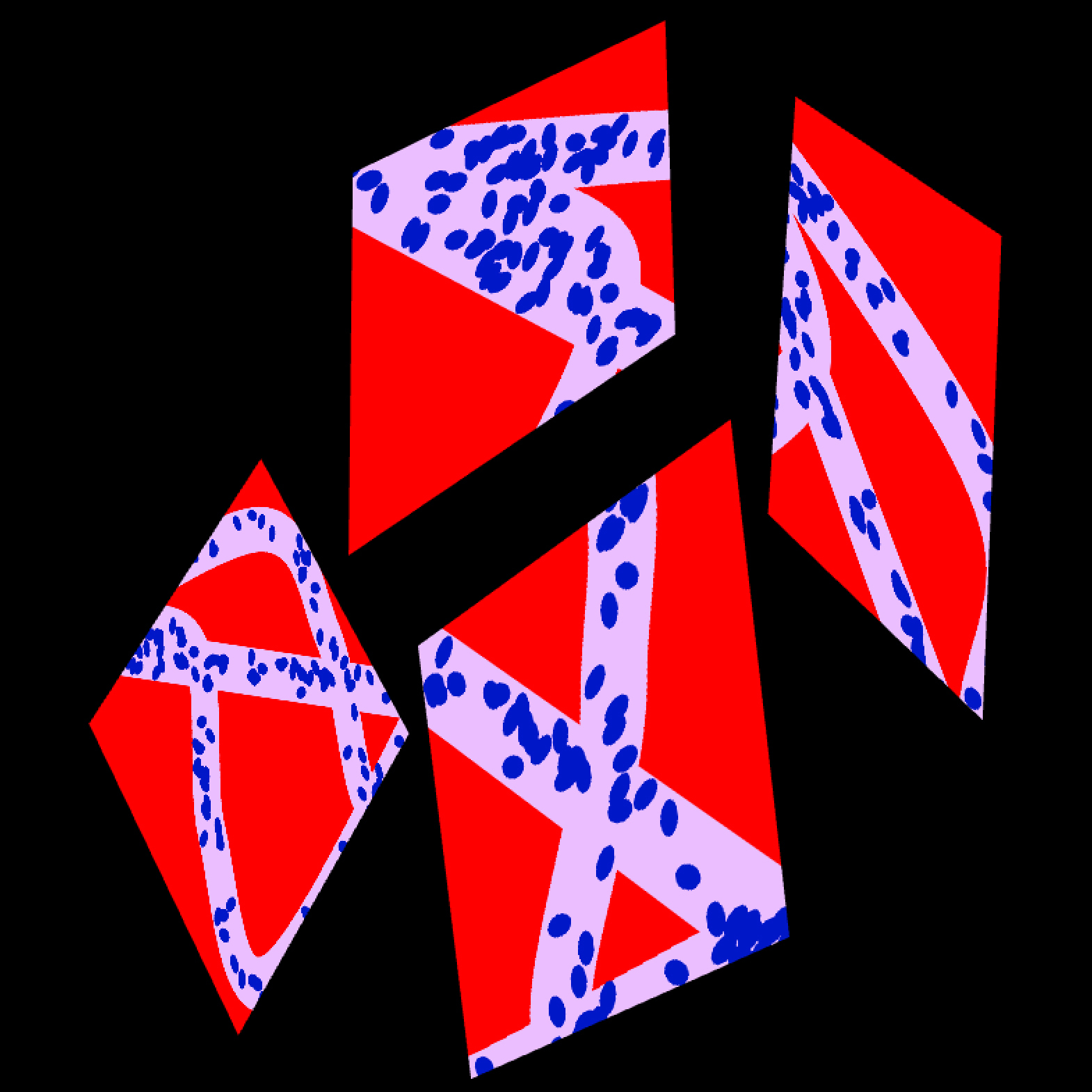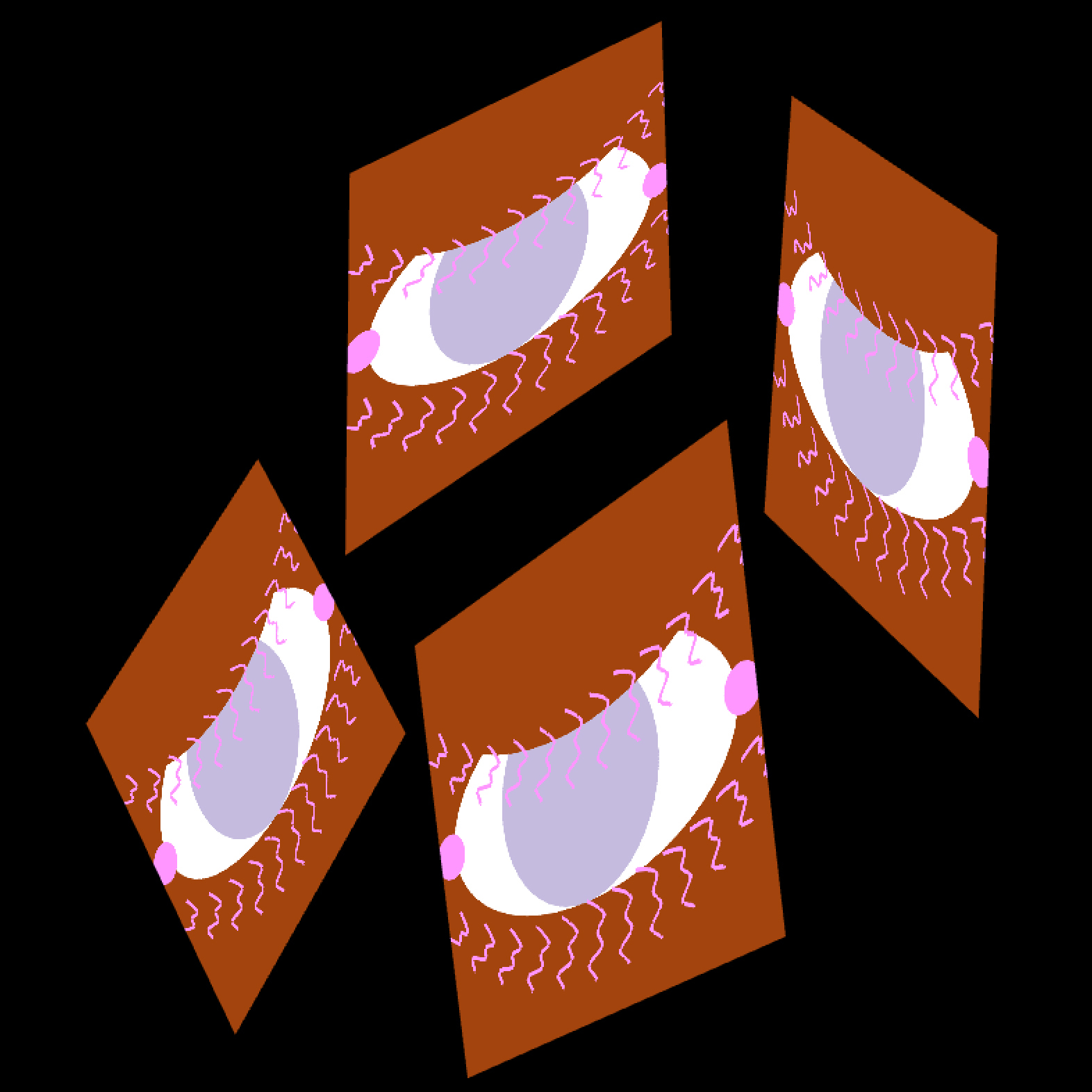Five Levels of Biological Organisation (Blobs All the Way Down)
A projection-mapped generative artwork that visualises five levels of biological organisation with different particle simulation methods.
produced by: Eevi Rutanen
Concept and background research
It seems to me that in generative artworks, and especially in generative projections, both the visual language and the technical features tend to be rather generic. Repetitive movements, geometric shapes, monochromatic colours and a certain mechanistic and rigid aesthetic and feel dominate the majority of generative artworks, partly due to conformity and partly to the inherent qualities of programming.
In Five Levels of Biological Organisation (Blobs All the Way Down) I wished to evade this conformity by creating a projection-mapped generative art piece that exhibits a variety of organic-looking movements, shapes and processes. Visually, I wanted to display my own aesthetic style that combines the preciseness and brutality of infographics with naive abstraction, cuteness and humour. From the technical perspective, I wished to simulate biological processes by combining different generic functions, like pseudo-randomness, noise and sine waves in a way that portrays the complex yet structured functions of living organisms. By having both pattern-like particle systems and distinctive bold shapes I wished to create changing compositions with different scales that would suit our group’s projection mapping shape. In addition, I wanted to explore different ways to simulate particle systems, so I decided to visualise the different levels of biological organisation: the cell, the tissue, the organ, the organ system, and finally, the organism.
Technical
The Cell
For the cellular level I wanted to portray two aspects: symbiogenesis and exponential growth. Symbiogenesis (or endosymbiotic theory) holds that the organelles in eukaryote cells evolved from symbiotic bacteria that got inside of other single-celled organisms (Kozo-Polyansky, 2010). The scene begins with the event of a single bacteria penetrating the cell’s membrane and starting the chain of reproduction. I used a combination of rotation, sine wave and noise for an organic-looking movement for the bacteria. For the exponential reproduction I first tried to use a recursive function, but the steps could not be animated since the recursion can only be displayed when it has been finished. I ended up creating a class for the cell object, and writing a timed function that creates two children for the cell and deletes the parent cell. The time of reproduction is determined by the cell’s age, which is a variable of the cell class, as well as each cell’s location and speed, and the location and movement of the individual cell organs. The fluctuating shape of the cell was achieved with noise, inspired by the Noisy Sun exercise on week 5 of the course (Papatheodorou, 2017).
The Tissue
After using basic particle collisions on the cell level, I wished to go further than bumping the cells from the edges of the FBO. I came up with the idea of simulating blood cells colliding inside a randomly generated blood vein, which turned out to be way more difficult than expected. After a lot of trial and error I developed a surprisingly simple solution: Constantly determining the closest point on the vein Polyline object for every particle, counting the distance to that point, and rotating the speed vector of the particle if the distance exceeds the vein radius, i.e. the particle hits the vein wall. Adding some rotation to the colliding particles created quite a good impression of real physics. This approach worked surprisingly well also for forking veins where the Polyline crosses itself.
The Organ & The Organ System
As a side product of the struggle with collisions inside a tube, I came across an idea how to move particles along a Polyline: Similarly determining the closest point on the Polyline, getting the tangent vector of the point, and setting the speed vector of the particle equal to the tangent. Quite happy with this (again surprisingly) simple solution, I decided to accommodate that to the next level of organisation. Using the age of the particles I also interpolated the colour of the blood from oxygenated red when it leaves the heart to oxygen-depleted blue when it returns to the heart after travelling the vascular system.
Different from the pattern-like visuals of the cell and tissue levels, I wanted to create an organ system with individual movements and shapes that could be divided on the projection surfaces as discrete but continuous parts. Again, by combining noise, randomness, sine waves, rotation and linear movement, I wished to achieve an impression of the complex interplay of circulatory, respiratory and digestive systems.
The Organism
The eye that represents the human body in its entirety came to be as I wanted to create smooth transitions between the scenes and also have some kind of subject or main character for the entire piece. My initial idea was to zoom out from every level of organisation to reveal the next, but visually and technically it didn’t work out as expected. In the end I didn’t have enough time to implement the transitions quite as well as I had planned.
Self evaluation
I wasn’t first quite happy with how the animations looked like on the screen, but I think when projected to the surfaces the piece really came alive. For this I also have to give credit to our group’s selected shape, which turned out even better than expected. The limited number of surfaces in our semi-opaque acrylic mobile made the mapping easy and the designing of the visuals straight-forward, but it still looked impressive in the dark space. However, I’m a bit disappointed we had to give up on having one circle shape in addition to the squares, since we didn’t have time to implement a circle surface on PiMapper.
Because we weren’t sure of the final layout of the mobile before installing it, I didn’t play with the order and dimensions of the surfaces as much as I could have. I could also have paid even more attention to the transitions between scenes and varied the rhythm and order of the scenes more. Overall I think I succeeded in my goal of creating a unique-looking projection-mapped generative artwork that transcends the conventions of the genre.
References
Kozo-Polyansky, B. M. (2010) Symbiogenesis: A New Principle of Evolution. Harvard University Press.
Papatheodorou, T. (2017) Noisy Sun, in Workshops in Creative Coding 1, Week 5.


































































